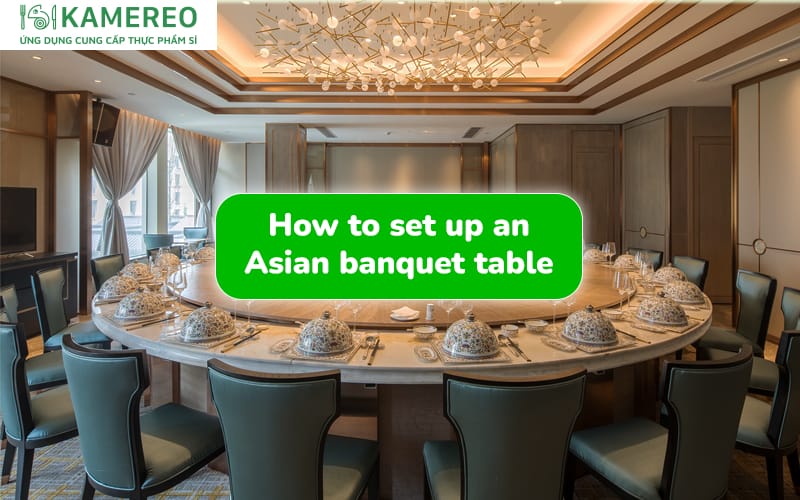In the food service industry, setting up an Asian dining table is not merely about arranging utensils; it’s an art that expresses professionalism and attentiveness. A harmoniously and correctly arranged table elevates the diner’s experience, leaving a lasting impression. From selecting the right tools to positioning each item, every detail contributes to creating an authentic East Asian dining space. Refer to the article below from Kamereo for more useful and detailed information!
Essential Tools for Setting Up an Asian Dining Table
The tools used for an Asian-style table setting are generally less elaborate than those for a European style but still require completeness, meticulousness, and sophistication:
- Charger plate/Underplate: Often used as a base for the eating bowl, placed at the center of the seating position.
- Rice bowl: Used for rice or soup, common in Asian banquets.
- Dipping sauce dish: Small type, used for individual dipping sauces.
- Ceramic spoon, chopsticks: Basic and indispensable eating utensils.
- Chopstick rest, spoon rest: Helps keep chopsticks and spoons tidy and hygienic.
- Centerpiece items: Spice holders, toothpick holders, and decorative flower vases.
- Glasses, cups, tea cups: Used for water, wine, or tea.
- Napkin: Can be cloth or paper, folded decoratively and placed on the bowl or plate.
Note: If the banquet serves international guests, it’s advisable to prepare additional forks and spoons to accommodate their dining habits.
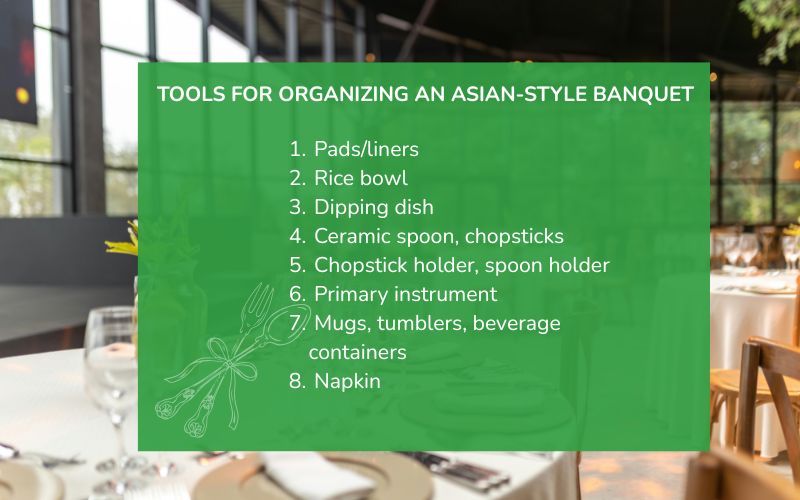
How to Set Up an Asian-Style Dining Table
Setting up an Asian dining table requires adherence to traditional arrangement rules, ensuring both aesthetic appeal and user convenience:
Rules for Setting Up an Asian-Style Dining Table
To create a professional and standard Asian dining table, the arrangement of eating utensils must follow certain rules to impress every diner:
- Charger plate (underplate): Usually a ceramic plate with a diameter of about 18 – 20cm, placed directly in front of the guest’s seat and approximately 2cm from the table edge.
- Eating plate: A smaller plate (about 12 – 15cm) placed on top of the charger plate.
- Napkin: A cloth or paper napkin folded neatly into a suitable shape, creating a focal point and placed on the eating plate or the rim of the water glass.
- Eating bowl: The eating bowl is usually placed upside down on the charger plate at the diner’s seating position, especially for round tables.
- Chopsticks: Chopsticks are placed on a chopstick rest, at ⅓ of their length, approximately 2cm from the charger plate, with the base of the chopsticks 1-2cm from the table edge.
- Spoon: The eating spoon is placed on a spoon rest, 2-3cm from the chopsticks. If the chopstick rest and spoon rest are combined, the eating spoon will be placed to the left of the chopsticks, 2-3cm from the plate.
- Dipping sauce bowl: A small bowl for dipping sauce is placed directly in front of the charger plate, about 1-2cm from the plate.
- Glass: The water glass or other beverage glass is placed on the right side, directly in front of the charger plate.
- Salt and pepper shakers: Placed at the center of the dining table.
- Toothpick holder: Also placed in the center of the table along with other condiments.
- Decorative flower vase: Placed at the center of the table to enhance aesthetics and create a cozy atmosphere.
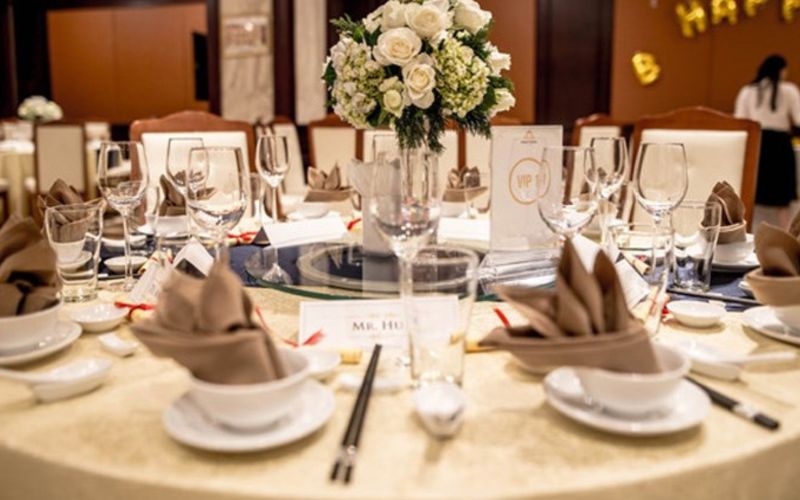
How to Set Up a Traditional Asian-Style Dining Table
Setting up a traditional Asian-style table emphasizes balance and convenience during the meal:
Step 1: Prepare and inspect the space:
- Ensure the tablecloth is fresh, clean, and wrinkle-free.
- Pull chairs so they are even with the edge of the tablecloth and adjust them symmetrically and neatly.
Step 2: Arrange utensils on a tray:
- To save time and ensure hygiene, gather all necessary utensils onto a tray before arranging them. This helps you move and arrange them systematically, avoiding omissions.
Step 3: Arrange the table in a traditional style:
- Charger plate/Underplate: Place in the center, opposite the guest’s seat, 2cm from the table edge.
- Eating bowl: Place upside down on the charger plate.
- Chopstick rest: Place to the right of the charger plate, 2cm from the plate.
- Chopsticks: Place on the chopstick rest, ensuring the base of the chopsticks is 2cm from the table edge.
- Ceramic spoon: Place 2cm from the chopsticks and 2cm from the table edge. If there is a spoon rest, place the spoon on it.
- Dipping sauce bowl: Place on the upper right side and 2cm from the chopsticks.
- Water glass: Place above and 1cm from the eating chopsticks.
- Wine/beer glass: Place at a 45-degree angle from the water glass, 1cm away.
- Centerpiece items (flower vase, fish sauce dispenser, soy sauce dispenser): For a round table, these items will be placed in the center. For a square table, place the flower vase at one end and condiment dispensers at the other end symmetrically, with the soy sauce dispenser on the right and the fish sauce dispenser on the left.
- Napkin: Fold neatly, place inside the eating bowl, angled up at 45 degrees to create a focal point.
Step 4: Re-check everything:
- Verify that all utensils are complete, clean, and arranged in the correct positions and distances. Adjust if necessary to ensure symmetry and neatness.
- Re-align chairs neatly, in a straight line, and ensure no food crumbs are left on the table or chairs.
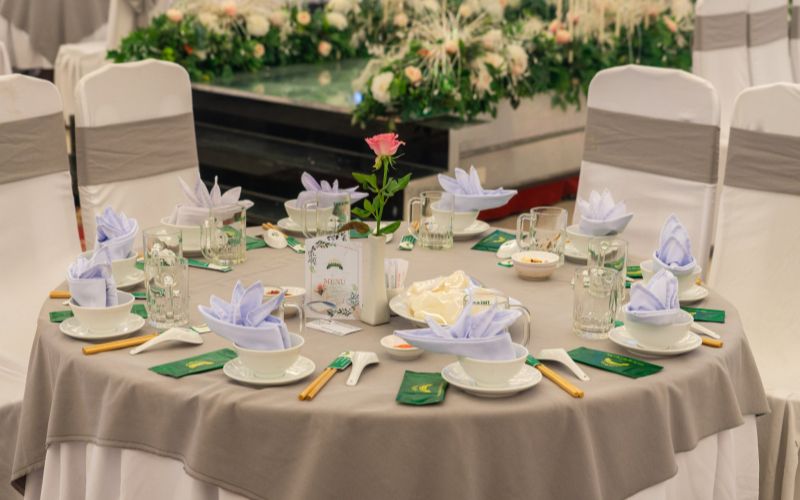
How to Set Up an Asian-Style Dining Table for International Guests
Setting up an Asian-style table for international guests is basically similar to the traditional style. However, the main difference is the addition of forks and spoons to accommodate diners who are not accustomed to using chopsticks:
Step 1: Prepare the space and inspect:
- Check the tablecloth to ensure it is clean and wrinkle-free.
- Adjust chairs symmetrically and neatly at each position.
Step 2: Arrange utensils on a tray and set the table:
- Gather all necessary eating utensils onto a tray for convenient movement and arrangement.
Step 3: Arrange the table in an international style:
- Charger plate: Place in the center of the seating position, 2cm from the table edge.
- Main eating spoon: Place to the right of the charger plate, 2cm from the plate.
- Chopstick rest: Place on the right side, with the top edge of the chopstick rest level with the main eating spoon, the end of the chopstick rest about 1cm from the spoon.
- Chopsticks: Place on the chopstick rest, ensuring the base of the chopsticks is 2cm from the table edge.
- Dipping sauce bowl: Place on the charger plate, 2cm from the plate.
- Fork: Place to the left of the charger plate, 2cm from the plate.
- Rice bowl: Placed on the charger plate, on the upper left side of the charger plate, angled at 45 degrees. The ceramic spoon is placed face up on the rice bowl, always rotated towards the 9 o’clock direction.
- Water glass: Placed above the chopsticks, 2cm away. The hard liquor glass is placed at a 45-degree angle from the water glass and 1cm away.
- Centerpiece items: Placed symmetrically at both ends of the table or in the middle of the table depending on the table shape.
- Napkin: Placed neatly on the charger plate.
Step 4: Re-check everything:
- Thoroughly review to ensure all utensils are complete, clean, and arranged in the correct positions, with appropriate and balanced spacing.
- Re-align chairs neatly, in a straight line, and check that no food crumbs remain on the table.
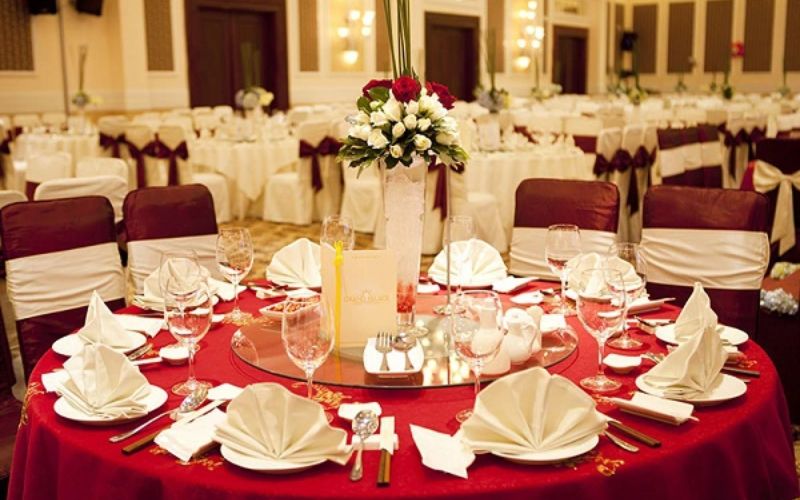
Important Notes When Setting Up an Asian-Style Dining Table
To make your Asian banquet table truly professional and impress diners, don’t overlook these important notes:
- Hygiene is the top priority: Always ensure the dining area is absolutely clean. Tablecloths must be replaced, washed thoroughly, ironed flat, and neatly folded after each service shift to maintain the best service quality.
- Clean and sparkling utensils: All eating utensils such as plates, bowls, chopsticks, spoons, etc., must be thoroughly washed, dried, and polished.
- Ensure hygiene during operation: When setting up the table, always use a service towel as a barrier on your hand, avoiding direct finger contact with eating utensils, especially plates.
- Accurate charger plate placement: The charger plate (underplate) needs to be placed in an accurate and symmetrical position relative to the diner’s seat.
- Condiment bottle labels facing outwards: Condiment bottles like fish sauce, soy sauce, salt, and pepper need to have their labels facing outwards for easy identification by diners.
- Avoid placing too many same-material utensils close together: Limit placing more than 3 utensils of the same material (e.g., 3 ceramic plates) too close to each other to avoid a cluttered and unappealing look.
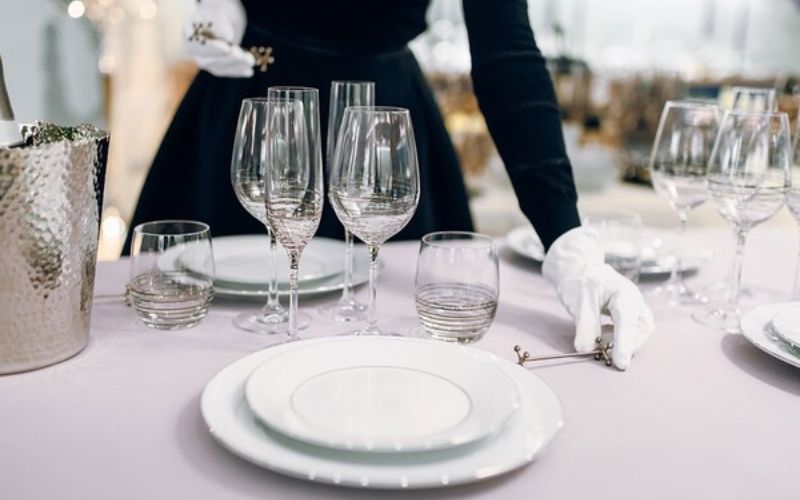
Kamereo – Wholesale Food Supply Application for Restaurants to Optimize Purchasing Processes
Kamereo is a wholesale food supply application specializing in providing high-quality food and ingredients, meeting all the needs of F&B businesses. With its “All-in-one supplier” model, Kamereo offers superior convenience by integrating a full range of items from fresh and frozen foods, beverage ingredients, to kitchen utensils, all from a single supplier.
To ensure product quality is always at its best, Kamereo focuses on investing in a modern storage system. This system includes specialized cold rooms and freezer rooms, helping to preserve food freshness longer without affecting quality. Furthermore, Kamereo strictly applies the FIFO principle, committed to dispatching food according to the correct first-in, first-out process, eliminating the problem of old stock accumulation.

A prominent feature of Kamereo compared to traditional suppliers is its smart electronic invoicing system. Customers will receive an instant VAT invoice after payment, significantly reducing the risk of document loss. This feature also helps businesses simplify and transparentize their financial reporting processes.
In addition, Kamereo optimizes speed and accuracy in its delivery service, supporting flexible ordering until midnight and fast delivery. With an on-time delivery rate of over 99% and a full delivery rate of over 98% of products, with errors below 0.5%, Kamereo provides absolute peace of mind regarding a continuous and stable supply for restaurants.
Conclusion
We hope that with the detailed instructions on setting up an Asian dining table shared in this article, you can confidently create sophisticated and impressive dining spaces. From preparing utensils to adhering to arrangement rules, every step contributes to enhancing the diner’s experience. To discover more effective business and restaurant management tips, don’t forget to explore Kamereo’s Business Tips section!
See more:



